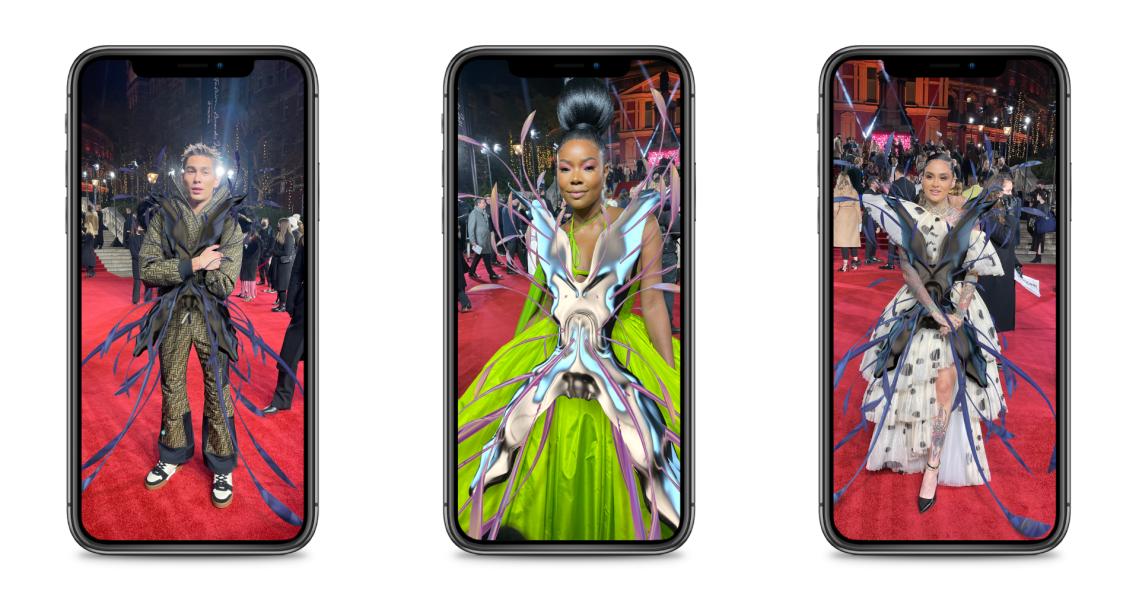This year’s British Fashion Awards, held on November 29, had one new addition this year on the red carpet: AR digital fashion. Now, the digital accessory that was worn by multiple celebrities and designed by the Institute of Digital Fashion is set to be sold on Friday night on digital marketplace The Dematerialised.
Worn via an AR filter on the red carpet by Gabrielle Union, Kehlani, Munroe Bergdorf and Leomie Anderson, among others at the BFC Fashion Awards, the expansive winged body piece is now being sold as an NFT. This is the first time that an NFT worn by celebrities on the red carpet is becoming accessible to the public. The piece was designed by Leanne Elliot Young and Cattytay, founders of the Institute of Digital Fashion, a collective focused on developing digital fashion. It takes advantage of the unique properties that digital garments can have, in that their modulating chrome design can be applied on any body, making them inclusive to all. Alone, the IoDF Instagram post featuring the filter earned 12,000 views.
With four different types of NFT’s available, the tokens are intentionally priced to provide purchase opportunities for different types of crypto consumers. The NFTs will be launching at 7 p.m. GMT on The Dematerialised (DMAT) website. The first NFT tier, Meta-Fashion Onyx, will only have 250 NFTs available, at €20 ($22.54) each. The price includes a 2D collectible and a Snaplens virtual try-on.
The higher tier, Meta-Fashion Opal (€500/$562, 25 available), allow for manipulation of the design and a conversation with the IoDF founders. The highest tiers, Meta Fashion Obsidian and Crystal (€5,000/$5,651, 1 available each), allow for a bespoke tailoring experience on a photo of choice, VIP access to the IoDF Fashion Week in June, an IRL visit to the IoDF studio, and lunch with the IoDF co-founders.
Talking about the launch exclusively with Glossy, the IoDF co-founders wanted to highlight the importance for brands to enter the space in an authentic way. “It’s important to recognize the trajectory of NFTs and what they stand for — a decentralized digital landscape,” said Elliot Young. “This shouldn’t be seen by brands as a fleeting trend that they can just paste onto their brand to-do list to stay relevant. There should be thorough research and understanding of what this means for the industry globally.”
For both IoDF and DMAT, the NFT launch shows that events in the fashion industry, like the Fashion Awards, can benefit from consumer inclusion through technology like NFT’s. “Both IoDF and DMAT operate to ensure that anyone [with an internet connection and a smart device] can get involved with digital fashion and NFTs. We both work to remove barriers to entry and provide alternative systems and ways of thinking that are more inclusive” said Karinna Grant, co-founder of The Dematerialised.
Sustainability has been a topic of discussion, with regard to NFTs. The DMAT marketspace operates on the Lukso blockchain that uses the proof-of-stake consensus, saving more than 99% of energy compared to Ethereum. The Lukso blockchain has also partnered with DMAT and Re:Earth to plant a mangrove tree with every NFT purchase, as it offsets three to four more times of Co2 over its lifetime than trees on land.
Ad position: web_incontent_pos1




